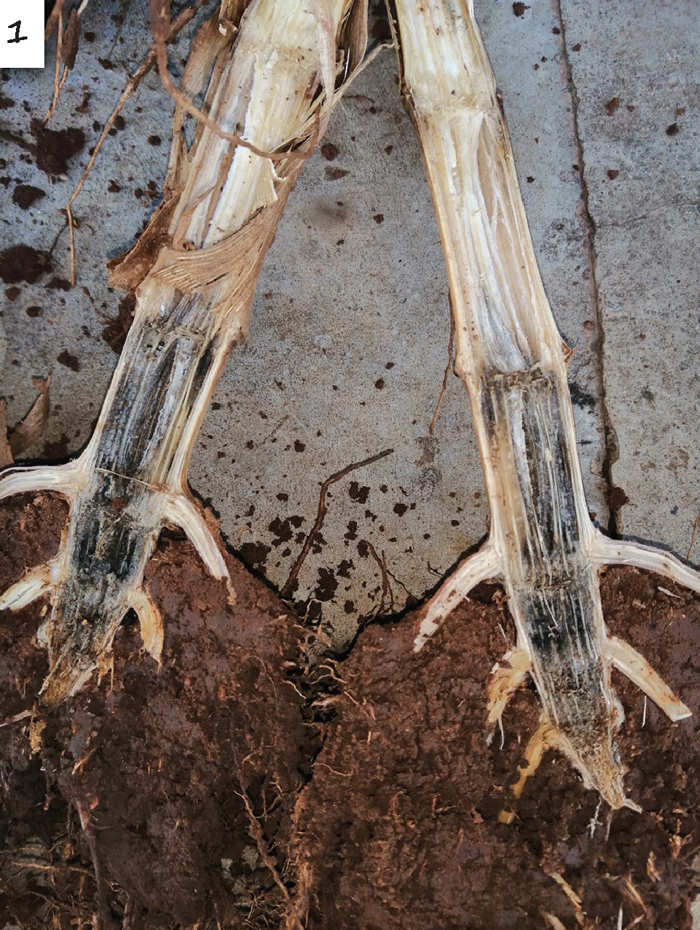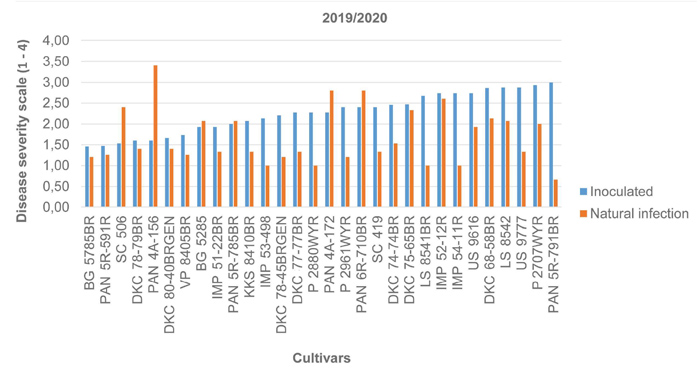
van Rensburg,
ARC-Grain Crops,
Potchefstroom
Charcoal root and stalk rot in maize are caused by the fungus Macrophomina phaseolina and are favoured by soil temperatures of 30°C to 42°C and low soil moisture.
Infections of the roots and crowns can lead to seedling death, a reduction of root formation and upward blockage of water and nutrients, whereas stalk rot infections can block the movement of water and nutrients, thereby weakening the stalk and reducing grain filling. In the event of a strong wind, weakened stalks will blow over and the producer will occur extra costs to lift plants to be able to harvest the maize ears.
Root rot infections can remain latent until environmental stresses such as drought or high temperatures occur during the flowering growth stage of maize plants. Symptoms become evident after flowering with the abnormal drying of upper leaf tissues, stalk lodging and premature death. When plants approach maturity, the lower stalk nodes (usually limited to the first five nodes) show a typical charcoal, grey-black discolouration. When the stalk is cut open, numerous black specks (microsclerotia) are visible in the shredded vascular bundles and on the inside of the stalk (Photo 1). Charcoal rot has a broad host range that includes soybean, sunflower, sorghum, maize, tobacco and a range of vegetable crops – making crop rotation ineffective as a management tool. The most effective and environmentally friendly management option remains the use of cultivars with resistance against charcoal rot.

Resistance screening
To determine their cultivar disease scores, 30 commercial maize cultivars were screened for resistance against charcoal root and stalk rot. The cultivars were selected from the national cultivar trials and planted in a field trial (with a high natural M. phaseolina inoculum count) in Potchefstroom, with three replications. Two rows of each cultivar were planted in each replication. The first row was inoculated with M. phaseolina-infected toothpicks before flowering, while the second row was left to be naturally infected. To conduct disease ratings of the roots and stalks from the individual cultivars, plants were split open and the lesion size captured according to a disease severity scale1. Naturally infected plants were scored for infection from the roots to the crowns and upwards, whereas inoculated plants were scored in the area of the inoculation site of the stalk.
Cultivar disease scores in this study ranged from 1 to 4, where a score of 1 indicates a healthy stalk or slight discolouration at the site of inoculation. A score of 2, 3 or 4 means that up to 50%, 51% to 75% or 76% to 100% respectively of the inoculated internode are discoloured. A score of 5 means that 100% of the inoculated internode is discoloured with less than 50% discolouration of the adjacent internode. No scores were captured in this category.
The data were analysed by Nicolene Cochrane from ARC-Biometry Services, using a split-plot Anova with cultivars as main treatments and treatments (inoculated and non-inoculated) as sub-plots. From the Anova analyses, both cultivar and treatment had a highly significant effect on charcoal rot infection. Charcoal rot-infected toothpick-inoculated plants showed a mean disease score of 2,25 (lower than the previous year with a score of 3,41), while the naturally infected plants had a mean disease score of 1,68. This is similar to the previous year (1,63), although the methods differ (controls in the previous year were inoculated with clean, sterilised toothpicks).
Results
PAN 5R-791BR (3,00) was the cultivar with the highest mean average disease score (Photo 1) and the lowest mean average disease score was recorded for BG 5785BR (1,46). As a main effect, cultivars BG 5785BR (1,33), PAN 5R-785BR (1,37), VP 8405BR (1,50) and DKC 78-79BR (1,50) had significantly lower infection scores (P = 0,01) compared to the other cultivars. An interaction between the treatment (inoculated and naturally infected plants) and cultivar had a significant effect on infection scores (P = 0,01). Although cultivars SC 506 and PAN 4A-156 had low infection scores (Graph 1) with the toothpick method (1,53 and 1,60 respectively) at the adult plant stage, they had significantly higher scores under natural field infections (2,40 and 3,40 respectively), indicating they were more susceptible during the seedling stage. These results suggest that resistance screening should include both plant stages. M. phaseolina resistance information generated by the ARC-Grain Crops and funded by the Maize Trust can for a third year assist producers with cultivar choices for the management of charcoal stalk rot.

Least significant difference (LSD) treatment = 0,29
LSD cultivar = 0,82
LSD treatment x cultivar = 1,15
Reference
 Shekhar, M & Kumar, S. 2012. Inoculation methods and disease rating scales for maize diseases. Directorate of maize research, Indian Council of Agricultural Research. Pusa Campus, New Delhi, India.
Shekhar, M & Kumar, S. 2012. Inoculation methods and disease rating scales for maize diseases. Directorate of maize research, Indian Council of Agricultural Research. Pusa Campus, New Delhi, India.


















